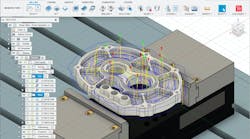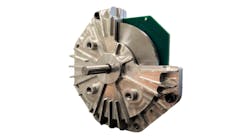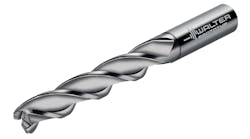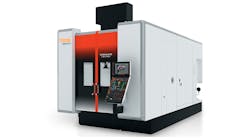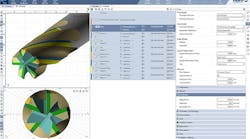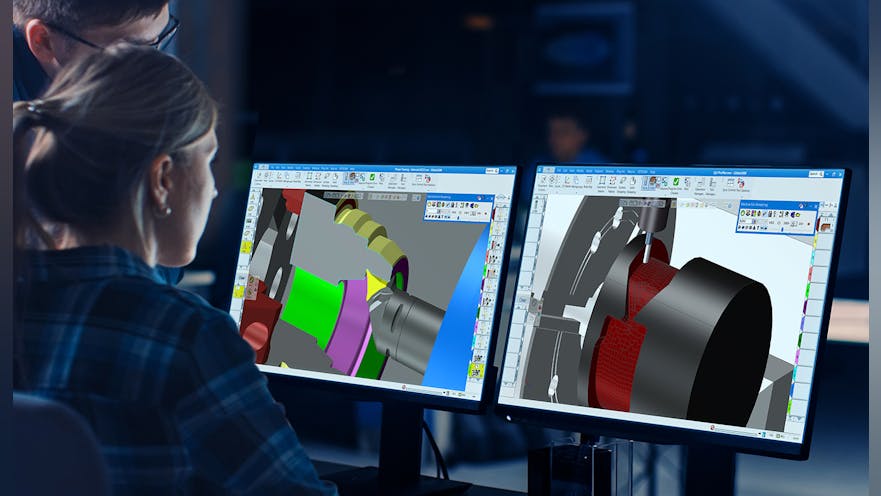CAD/CAM developer CAMBRIO released GibbsCAM 2023, highlighting new, core functions for CNC machining, plus new technology in collaboration with Sandvik Coromant.
GibbsCAM 2023 features a number of significant turning process enhancements, including the highly effective implementation of Sandvik Coromant’s PrimeTurning™ strategies. These new cutting methodologies permit turning and facing in all directions, delivering dramatic increases in high volume production rates. PrimeTurning™ has been proven to deliver cycle time reductions of up to 50%, and more than 500% increase for insert tool life. PrimeTurning™ uses the slope of the insert for chip thinning to allow you to make heavy cuts and spread cutting forces and heat over a larger portion of the cutting edge, which in turn contributes to longer tool life.
In addition, PrimeTurning™ adapts the feed rate (excellent for cutting on a taper) to constantly manage chip thickness – which is ideal for high-volume and unattended environments. PrimeTurning™ supports two new tool types (CoroTurn® Prime Type-A with three 35° corners for finishing and fine roughing / getting into grooves etc.; and CoroTurn® Prime Type-B with two strong corners for bulk roughing / heavy cutting) that each use a low lead-angle to improve surface finish.
Other enhancements include a new option in most turning processes to control cutting load variation in order to suppress resonance-induced chatter and improve chip breaking for CNC machines. (This machine capability is also called variable spindle speed by Okuma, and low frequency vibration by Citizen.) VoluTurn functionality has been extended to manage the active control of chip thickness during the cut by varying the feed rate instantaneously with any changes in cut depth.
Thread turning operations have been expanded with Face Threading, Variable Pitch Threading, Multi-pitch, and Position Tool Front options. Users can produce a spiral thread on the face of a part, vary pitch threads incrementally per revolution, or generate different pitches on a continuous thread, with easy control of exact start/end specs in the tool dialog.
Alongside many other turning enhancements, GibbsCAM 2023 makes it possible to specify “rake and back relief” for tool inserts to more accurately define the 3D geometry of the tool inserts, to provide a tool representation that perfectly matches what the customer is experiencing. Also, the elliptical contour process now may be used for elliptical bores inside of solid parts, and iy supports a radial (Xr) stock offset for both inner diameter (ID) and outer diameter (OD) machining.
Cylindrical milling in GibbsCAM 2023 is easier with direct selection of a “slice” in the CS depth axis: select a closed profile to machine a cylindrical boss or pocket; or select two loops to machine a groove or ring without the need to extract edge geometry and unwrap the shape. New spiral boring functionality cuts a spiral out to the full diameter at each Z step, which increases cutting feed rate and depth due to a more consistent tool load.
In addition, the Mill Roughing function now can now omit cavity areas to support high-speed mill tools that cannot plunge or ramp.
GibbsCAM 2023 extends the default drill cycle types to include five more: gun drilling, variable peck (full out and chip breaker), and peck tap (full out and chip breaker). A new, “multifunction insert drill” type is supported and can be used to perform both turning and drilling/boring operations (such as the Sandvik Coromant CoroDrill® 880 series.)
The multifunction insert drill tool type can seamlessly switch between turning, lathe drilling, and mill drilling without retraction or tool change motions.
Also included is a new option for lathe drilling with counter-rotating tools that instructs the live tooling spindle to turn in the opposite direction at a specified RPM, to effectively increase spindle speed and significantly boost material removal rates.
A number of new features for machine support include the ability to set tool changes from alternate origins. This now includes the ability to set the tool change home location based on Part (as in previous versions), Part Station, Machine, or Tool Group. In addition, it is also possible to flag tool motions with abnormally high feedrates and provide a safety warning to the operator. Alongside new simulation modes, such as Fixture Visibility, GibbsCAM 2023 significantly boosts its simulation feature set.
Last, GibbsCAM 2023 lets machinists categorize and organize workgroups and coordinate systems within a part, and specify active and inactive operations which significantly helps users to part information throughout the CAM workflow, especially with large, complex machining processes. To improve ease of use, new tabs have been added to allow the setting of work areas limits on a part-by-part basis and assign to new toolpath operations. In addition, the Work Fixtures tab within the Post Processor dialog can now group offsets in use by operation coordinate system. This increases visibility and program safety when multiple coordinate systems are used on a single fixture offset.
